Habitat Suitability Evaluation of Chinese Red Panda in Daxiangling and Xiaoxiangling Mountains
Simple Summary
Abstract
1. Introduction
2. Materials and Methods
2.1. Study Area
2.2. Study Subject
2.3. Data Processing
2.3.1. Species Data
2.3.2. Environmental Variables
2.4. Construction and Analysis of the MaxEnt Model
3. Results
3.1. Model Construction
3.1.1. Results of Habitat Suitability Model Construction for Red Pandas
3.1.2. Habitat Selection Results of Red Pandas
3.2. Comparison of Suitable Habitat Areas for Red Pandas Between Daxiangling and Xiaoxiangling Mountain Ranges
4. Discussion
5. Conclusions
Author Contributions
Funding
Institutional Review Board Statement
Informed Consent Statement
Data Availability Statement
Acknowledgments
Conflicts of Interest
Abbreviations
| DXL | Daxiangling |
| XXL | Xiaoxiangling |
References
- Adhikari, D.; Barik, S.; Upadhaya, K. Habitat distribution modelling for reintroduction of Ilex khasiana Purk, a critically endangered tree species of northeastern India. Ecol. Eng. 2012, 40, 37–43. [Google Scholar] [CrossRef]
- Barua, M. Mobilizing metaphors: The popular use of keystone, flagship and umbrella species concepts. Biodivers. Conserv. 2011, 20, 1427–1440. [Google Scholar] [CrossRef]
- Barnosky, A.D.; Matzke, N.; Tomiya, S.; Wogan, G.O.U.; Swartz, B.; Quental, T.B.; Marshall, C.; McGuire, J.L.; Lindsey, E.L.; Maguire, K.C.; et al. Has the Earth’s sixth mass extinction already arrived? Nature 2011, 471, 51–57. [Google Scholar] [CrossRef]
- Berger, J. The last mile: How to sustain long-distance migration in mammals. Conserv. Biol. 2004, 18, 320–331. [Google Scholar] [CrossRef]
- Curran, L.M.; Trigg, S.N.; McDonald, A.K.; Astiani, D.; Hardiono, Y.M.; Siregar, P.; Caniago, I.; Kasischke, E. Lowland forest loss in protected areas of Indonesian Borneo. Science 2004, 303, 1000–1003. [Google Scholar] [CrossRef]
- Waldron, A.; Mooers, A.O.; Miller, D.C.; Nibbelink, N.; Redding, D.; Kuhn, T.S.; Roberts, J.T.; Gittleman, J.L. Targeting global conservation funding to limit immediate biodiversity declines. Proc. Natl. Acad. Sci. USA 2013, 110, 12144–12148. [Google Scholar] [CrossRef]
- Xu, W.; Viña, A.; Kong, L.; Pimm, S.L.; Zhang, J.; Yang, W.; Xiao, Y.; Zhang, L.; Chen, X.; Liu, J.G.; et al. Reassessing the conservation status of the giant panda using remote sensing. Nat. Ecol. Evol. 2017, 1, 1635–1638. [Google Scholar] [CrossRef]
- Wei, F.; Feng, Z.; Wang, Z.; Zhou, A.; Hu, J. Current distribution, status and conservation of wild red pandas Ailurus fulgens in China. Biol. Conserv. 1999, 89, 285–291. [Google Scholar] [CrossRef]
- Hu, Y.; Thapa, A.; Fan, H.; Ma, T.; Wu, Q.; Ma, S.; Zhang, D.; Wang, B.; Li, M.; Li, Y.; et al. Genomic evidence for two phylogenetic species and long-term population bottlenecks in red pandas. Sci. Adv. 2020, 6, eaax5751. [Google Scholar] [CrossRef]
- Liu, X.; Zhang, M.; Liu, Z. Ecological research status of Ailurus fulgens, China. Chin. J. Wildl. 2011, 32, 38–40. (In Chinese) [Google Scholar]
- Glatston, A.; Wei, F.; Than, Z.; Sherpa, A. 2015 (Ailurus fulgens). In The IUCN Red List of Threatened Species, e.T714A110023718; errata version published in 2017; International Union for Conservation of Nature: Gland, Switzerland, 2015. [Google Scholar]
- Thapa, A.; Hu, Y.; Wei, F. The endangered red panda (Ailurus fulgens): Ecology and conservation approaches across the entire range. Biol. Conserv. 2018, 220, 112–121. [Google Scholar] [CrossRef]
- Thapa, A.; Wu, R.; Hu, Y.; Nie, Y.; Singh, P.B.; Khatiwada, J.R.; Yan, L.; Gu, X.; Hu, Y. Predicting the potential distribution of the endangered red panda across its entire range using MaxEnt modeling. Ecol. Evol. 2018, 8, 10542–10554. [Google Scholar] [CrossRef] [PubMed]
- Hu, J.; Wei, F. The feeding ecology of lesser panda. J. Sichuan Teach. Coll. Nat. Sci. 1992, 13, 83–87. (In Chinese) [Google Scholar]
- Wei, F.; Zhang, Z. Red pandas in the wild in China. In Red Panda; Elsevier: Amsterdam, The Netherlands, 2011; pp. 375–391. [Google Scholar]
- Thapa, A.; Hu, Y.; Aryal, P.C.; Singh, P.B.; Shah, K.B.; Wei, F. The endangered red panda in Himalayas: Potential distribution and ecological habitat associates. Glob. Ecol. Conserv. 2020, 21, e00890. [Google Scholar] [CrossRef]
- Pradhan, S.; Saha, G.K.; Khan, J.A. Ecology of the red panda Ailurus fulgens in the Singhalila National Park, Darjeeling, India. Biol. Conserv. 2001, 98, 11–18. [Google Scholar] [CrossRef]
- Wei, F.; Feng, Z.; Wang, Z.; Hu, J. Habitat use and separation between the giant panda and the red panda. J. Mammal. 2000, 81, 448–455. [Google Scholar] [CrossRef]
- Wei, F.; Feng, Z.; Wang, Z.; Zhou, J. Use of the nutrients in bamboo by the red panda (Ailurus fulgens). J. Zool. 1999, 248, 535–541. [Google Scholar] [CrossRef]
- Zhang, Z.; Hu, J.; Yang, J.; Li, M.; Wei, F. Food habits and space-use of red pandas Ailurus fulgens in the Fengtongzhai Nature Reserve, China: Food effects and behavioural responses. Acta Theriol. 2009, 54, 225–234. [Google Scholar] [CrossRef]
- Wang, W.; Wei, F.; Hu, J.; Feng, Z.; Yang, G. Preliminary study on habitat selection of red pandas in the Mabian. Acta Theriol. Sin. 2006, 18, 15. (In Chinese) [Google Scholar]
- Dorji, S.; Rajaratnam, R.; Vernes, K. The vulnerable red panda Ailurus fulgens in Bhutan: Distribution, conservation status and management recommendations. Oryx 2012, 46, 536–543. [Google Scholar] [CrossRef]
- Dendup, P.; Cheng, E.; Lham, C.; Tenzin, U. Response of the endangered red panda (Ailurus fulgens) to anthropogenic disturbances, and its distribution in Phrumsengla National Park, Bhutan. Oryx 2017, 51, 701–708. [Google Scholar] [CrossRef]
- Panthi, S.; Khanal, G.; Acharya, K.P.; Aryal, A.; Srivathsa, A. Large anthropogenic impacts on a charismatic small carnivore: Insights from distribution surveys of red panda Ailurus fulgens in Nepal. PLoS ONE 2017, 12, 1–14. [Google Scholar] [CrossRef]
- Acharya, K.P.; Shrestha, S.; Paudel, P.K.; Sherpa, A.P.; Jnawali, S.R.; Acharya, S.; Bista, D. Pervasive human disturbance on habitats of endangered red panda (Ailurus fulgens) in the central Himalaya. Glob. Ecol. Conserv. 2018, 15, e00420. [Google Scholar] [CrossRef]
- Yonzon, P.B.; Hunter, M.L., Jr. Conservation of the red panda (Ailurus fulgens). Biol. Conserv. 1991, 57, 1–11. [Google Scholar] [CrossRef]
- Panthi, S.; Wang, T.; Sun, Y.; Thapa, A. An assessment of human impacts on endangered red pandas (Ailurus fulgens) living in the himalaya. Ecol. Evol. 2019, 9, 13413–13425. [Google Scholar] [CrossRef] [PubMed]
- DNPWC; DFSC. Red Panda Conservation Action Plan for Nepal (2019–2023); Department of National Parks and Wildlife Conservation and Department of Forests and Soil Conservation: Kathmandu, Nepal, 2018.
- NCD. Red Panda Conservation Action Plan (2018–2023): Ensuring the Future of Red Panda Landscapes Through National and Regional Collaboration; Nature Conservation Division: Thimphu, Bhutan; Department of Forests and Park Services: Thimphu, Bhutan; Ministry of Agriculture and Forests: Thimphu, Bhutan, 2019.
- Zhu, G.; Liu, G.; Bu, W.; Gao, Y. Ecological niche modeling and its applications in biodiversity conservation. Biodivers. Sci. 2013, 21, 90. [Google Scholar] [CrossRef]
- Bhatta, M.; Zander, K.K.; Austin, B.J.; Garnett, S.T. Societal recognition of ecosystem service flows from red panda habitats in Western Nepal. Mt. Res. Dev. 2020, 40, R50. [Google Scholar] [CrossRef]
- Lowther, D.A. The first painting of the red panda (Ailurus fulgens) in Europe? Natural history and artistic patronage in early nineteenth-century India. Arch. Nat. Hist. 2021, 48, 368–376. [Google Scholar] [CrossRef]
- Su, H.; Bista, M.; Li, M. Mapping habitat suitability for Asiatic black bear and red panda in Makalu Barun National Park of Nepal from Maxent and GARP models. Sci. Rep. 2021, 11, 14135. [Google Scholar] [CrossRef] [PubMed]
- He, K.; Gu, X.D.; Huang, Y.; Zhang, H.M.; Li, D.S.; Zhou, X.; Yang, Z.S. Movement and activity of reintroduced giant pandas. Ursus 2019, 29, 163–174. [Google Scholar] [CrossRef]
- Ran, J.H.; Zeng, Z.Y.; Liu, S.C.; Wang, H.J. A survey of the Giant Panda population and habitat in the Daxiangling Mountains. J. Sichuan Univ. 2006, 43, 889–893. [Google Scholar]
- Liu, F.; McShea, W.J.; Li, D. Correlating habitat suitability with landscape connectivity: A case study of Sichuan golden monkey in China. Ecol. Model. 2017, 353, 37–46. [Google Scholar] [CrossRef]
- Fick, S.E.; Hijmans, R.J. WorldClim 2: New 1-km spatial resolution climate surfaces for global land areas. Int. J. Climatol. 2017, 37, 4302–4315. [Google Scholar] [CrossRef]
- O’Donnel, M.S.; Ignizio, D.A. Bioclimatic Predictors for Supporting Ecological Applications in the Conterminous United States; 2327-638X; US Geological Survey: Reston, VA, USA, 2012.
- Mu, H.; Li, X.; Wen, Y.; Huang, J.X.; Du, P.J.; Su, W.; Miao, S.X.; Geng, M.Q. A global record of annual terrestrial Human Footprint dataset from 2000 to 2018. Sci. Data 2022, 9, 176. [Google Scholar] [CrossRef] [PubMed]
- Phillips, S.J.; Anderson, R.P.; Schapire, R.E. Maximum entropy modeling of species geographic distributions. Ecol. Model. 2006, 190, 231–259. [Google Scholar] [CrossRef]
- Elith, J.H.; Graham, C.P.; Anderson, R.; Dudík, M.; Ferrier, S.; Guisan, A.E.; Zimmermann, N. Novel methods improve prediction of species’ distributions from occurrence data. Ecography 2006, 29, 129–151. [Google Scholar] [CrossRef]
- Liu, C.; Berry, P.M.; Dawson, T.P.; Pearson, R.G. Selecting thresholds of occurrence in the prediction of species distributions. Ecography 2005, 28, 385–393. [Google Scholar] [CrossRef]
- Ruan, T.; Han, H.; Wei, W.; Qiu, L.; Hong, M.; Tang, J.; Zhou, H.; Zhang, Z. Habitat suitability evaluation for giant panda in Liziping National Nature Reserve, Sichuan Province. Glob. Ecol. Conserv. 2021, 30, e01780. [Google Scholar] [CrossRef]
- Xiao, S.; Li, S.; Wang, X.; Chen, L.; Su, T. Cedrus distribution change: Past, present, and future. Ecol. Indic. 2022, 142, 109159. [Google Scholar] [CrossRef]
- Zhang, Z.; Mammola, S.; Liang, Z.; Capinha, C.; Wei, Q.W.; Wu, Y.N.; Zhou, J.; Wang, C.R. Future climate change will severely reduce habitat suitability of the Critically Endangered Chinese giant salamander. Freshw. Biol. 2020, 65, 971–980. [Google Scholar] [CrossRef]
- Shen, G.; Pimm, S.L.; Feng, C.; Ren, G.; Liu, Y.; Xu, W.; Li, J.; Si, X.; Xie, Z. Climate change challenges the current conservation strategy for the giant panda. Biol. Conserv. 2015, 190, 43–50. [Google Scholar] [CrossRef]
- Dendup, P.; Humle, T.; Bista, D.; Penjor, U.; Lham, C.; Gyeltshen, J. Habitat requirements of the Himalayan red panda (Ailurus fulgens) and threat analysis in Jigme Dorji National Park, Bhutan. Ecol. Evol. 2020, 10, 9444–9453. [Google Scholar] [CrossRef] [PubMed]
- Wei, W.; Swaisgood, R.R.; Pilfold, N.W.; Owen, M.A.; Dai, Q.; Wei, F.; Han, H.; Yang, Z.; Yang, X.; Gu, X.D.; et al. Assessing the Effectiveness of China’s Panda Protection System. Curr. Biol. 2020, 30, 1280–1286.e2. [Google Scholar] [CrossRef] [PubMed]
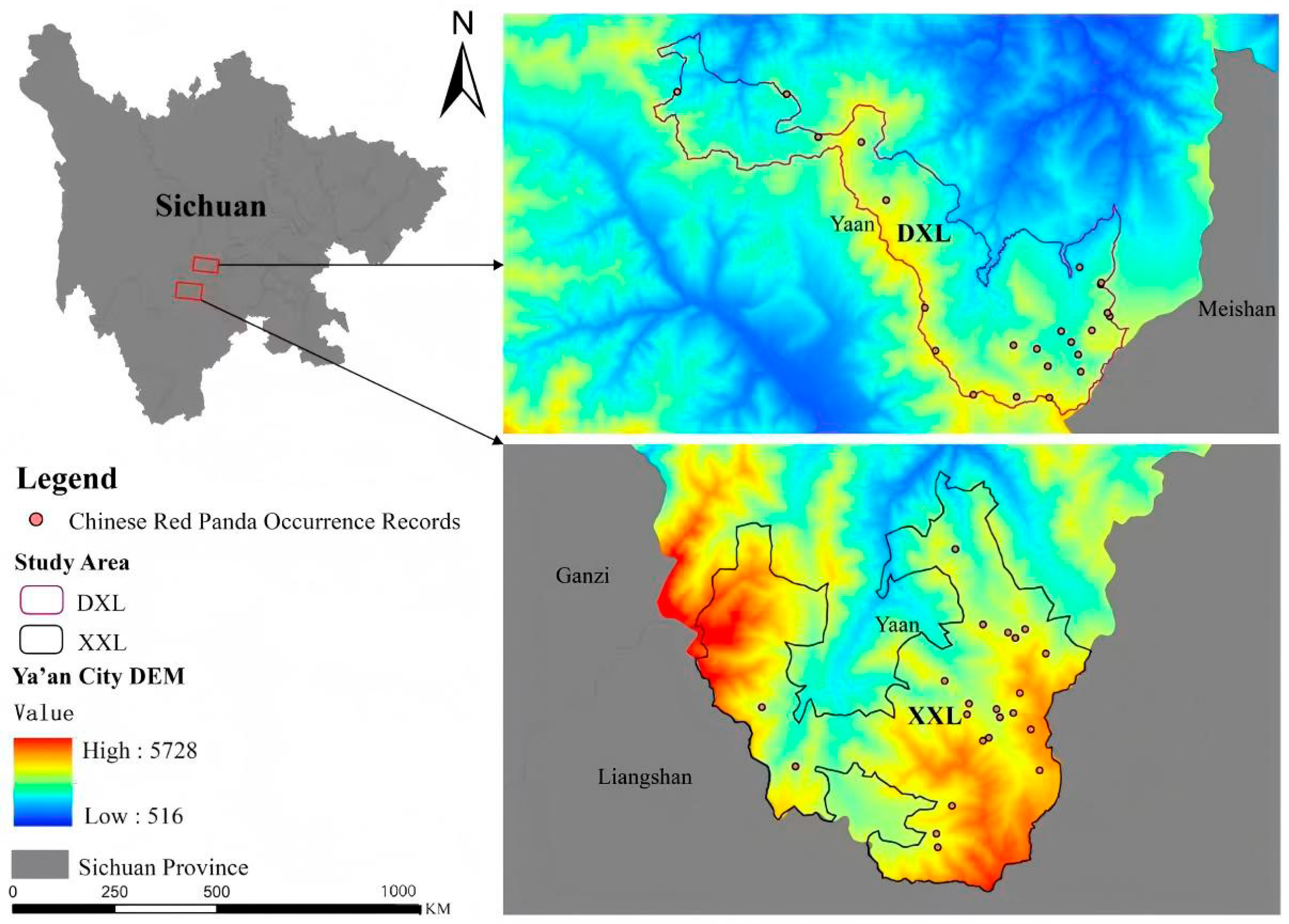
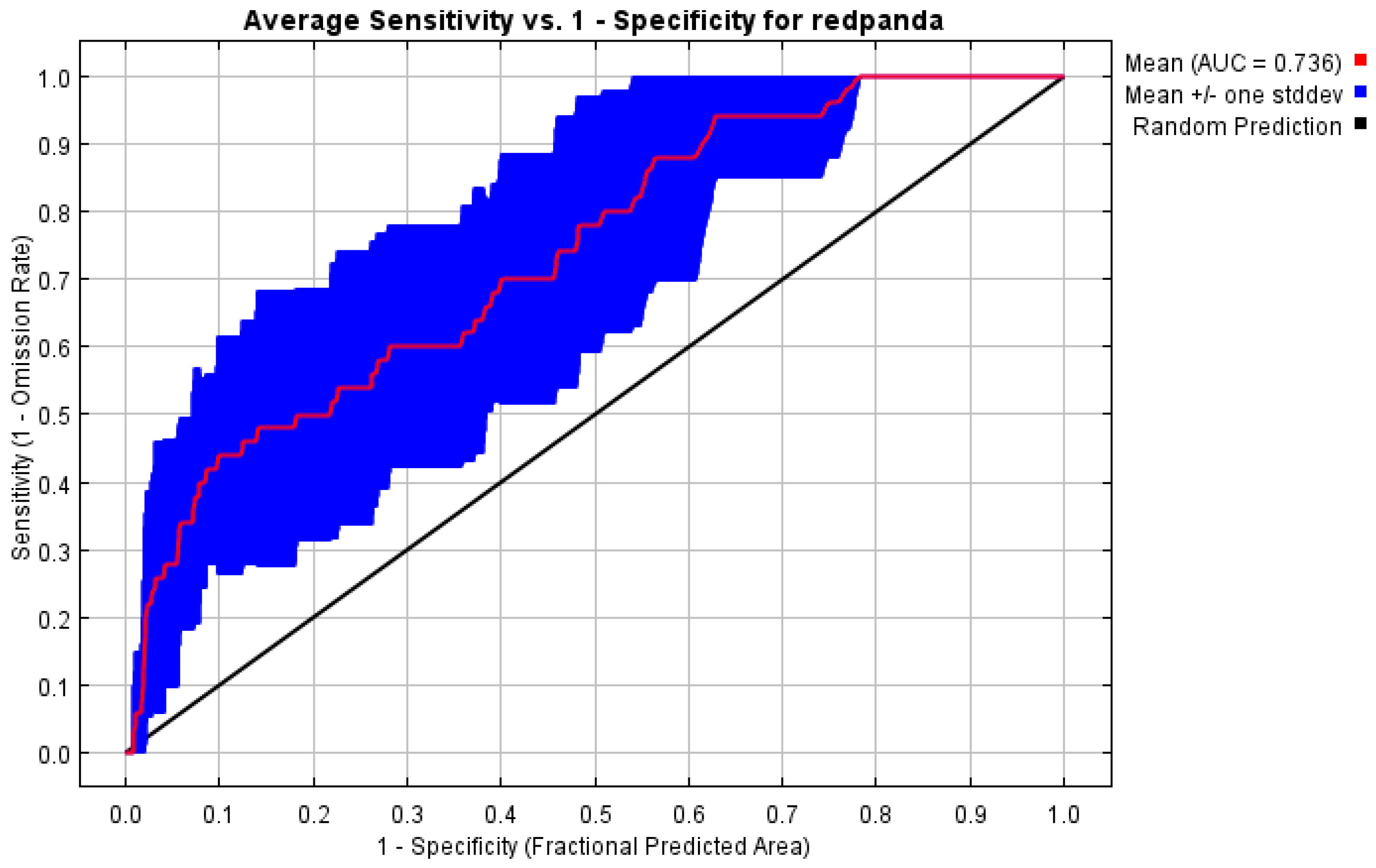

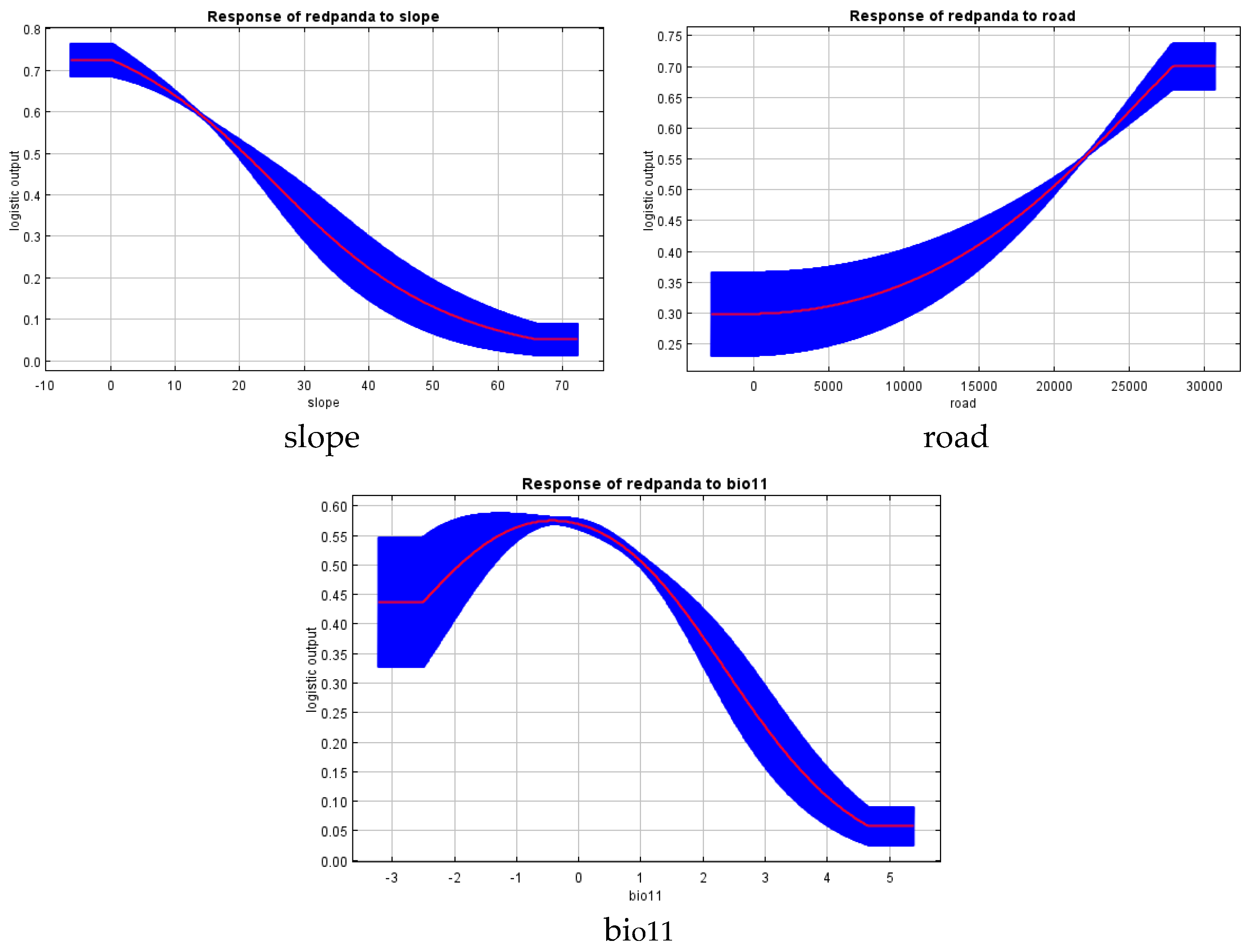

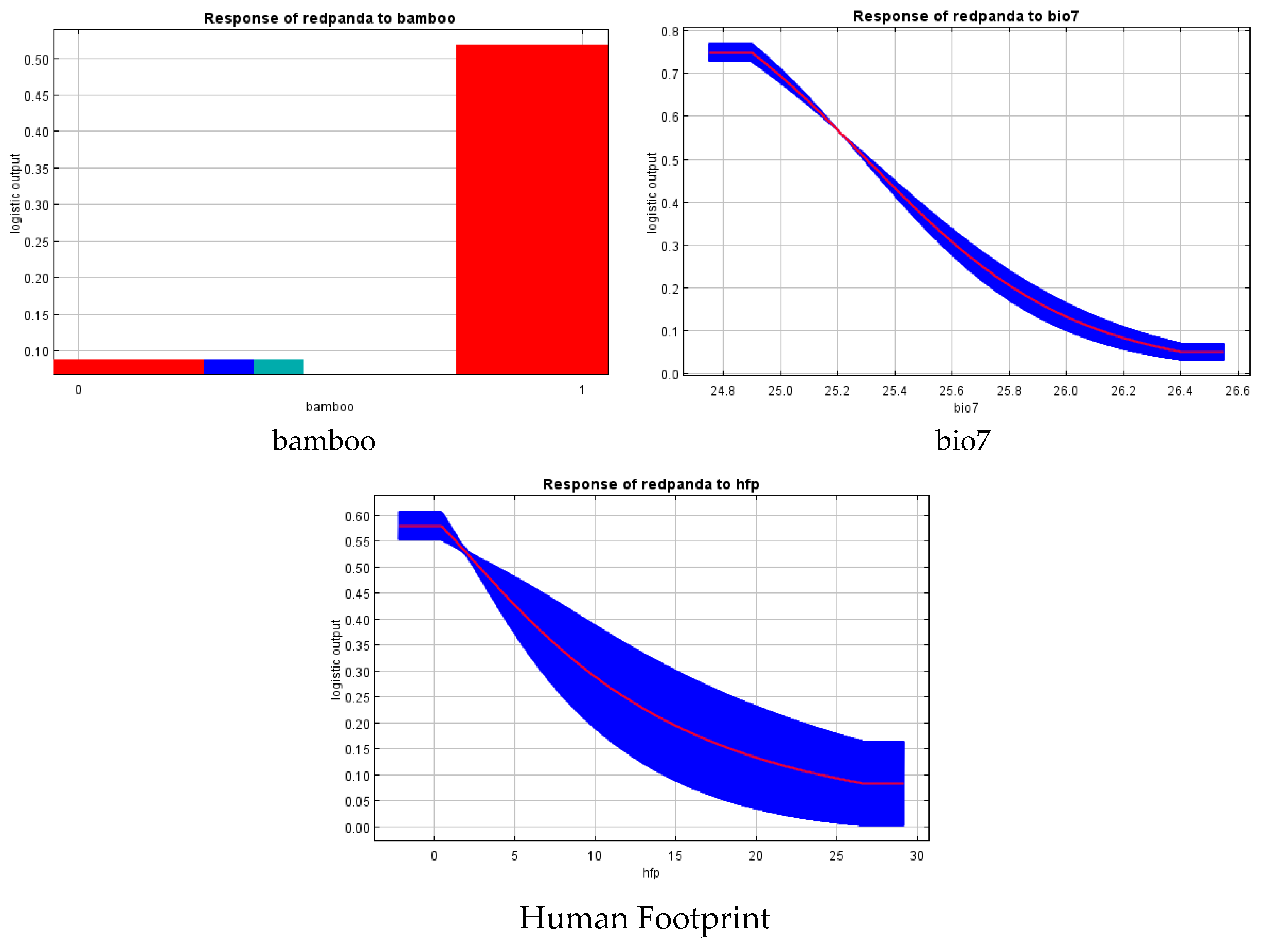
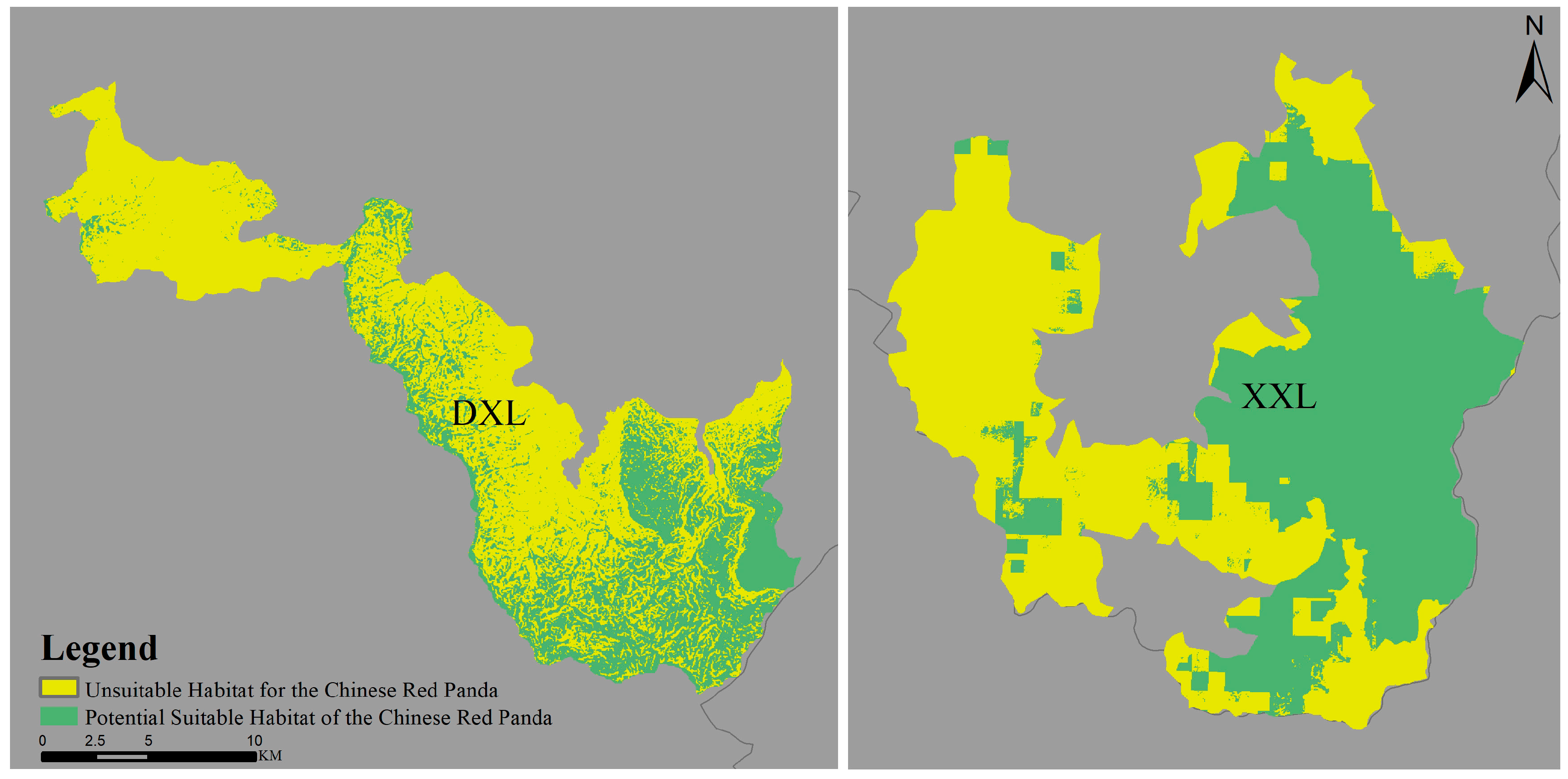
| Factor type | Environmental Factor | Factor Description | Unit |
|---|---|---|---|
| Climate | Bio1 | Average annual temperature | °C |
| Bio2 | Average monthly temperature difference between day and night | °C | |
| Bio4 | Temperature variation variance | °C | |
| Bio7 | Annual temperature variation range | °C | |
| Bio9 | Maximum dry quarterly average temperature | °C | |
| Bio11 | Average temperature in the coldest quarter | °C | |
| Bio13 | Maximum monthly rainfall | mm | |
| Bio15 | Precipitation seasonality | mm | |
| Bio17 | Maximum seasonal rainfall | mm | |
| Bio18 | Average rainfall in the hottest season | mm | |
| Bio19 | Average rainfall in the coldest season | mm | |
| Terrain | Altitude | The average elevation of the grid cell | m |
| Slope | The average slope of the grid cell | ° | |
| Road | Distance from the main road | m | |
| Aspect | The average slope of the grid cell | ° | |
| Disturbance | Human Footprint | The average intensity of human activity within a grid cell | |
| Vegetation | Vegetation | Divided into eight categories: cropland (CL), coniferous forest (NF), broad-leaved forest (BF), shrub (SL), grassland (GL), wetland (WT), residential land (RL), and bare land (BL) | |
| Bamboo | Binary variable (0—no, 1—yes) |
| Mountains | Predicted Habitat Area (km2) | Predicted Area Ratio (%) |
|---|---|---|
| DXL | 123.835 | 43.45 |
| XXL | 341.873 | 71.38 |
Disclaimer/Publisher’s Note: The statements, opinions and data contained in all publications are solely those of the individual author(s) and contributor(s) and not of MDPI and/or the editor(s). MDPI and/or the editor(s) disclaim responsibility for any injury to people or property resulting from any ideas, methods, instructions or products referred to in the content. |
© 2025 by the authors. Licensee MDPI, Basel, Switzerland. This article is an open access article distributed under the terms and conditions of the Creative Commons Attribution (CC BY) license (https://creativecommons.org/licenses/by/4.0/).
Share and Cite
Li, J.; Luo, W.; Zheng, H.; Li, W.; Yang, X.; He, K.; Zhou, H. Habitat Suitability Evaluation of Chinese Red Panda in Daxiangling and Xiaoxiangling Mountains. Biology 2025, 14, 961. https://doi.org/10.3390/biology14080961
Li J, Luo W, Zheng H, Li W, Yang X, He K, Zhou H. Habitat Suitability Evaluation of Chinese Red Panda in Daxiangling and Xiaoxiangling Mountains. Biology. 2025; 14(8):961. https://doi.org/10.3390/biology14080961
Chicago/Turabian StyleLi, Jianwei, Wei Luo, Haipeng Zheng, Wenjing Li, Xi Yang, Ke He, and Hong Zhou. 2025. "Habitat Suitability Evaluation of Chinese Red Panda in Daxiangling and Xiaoxiangling Mountains" Biology 14, no. 8: 961. https://doi.org/10.3390/biology14080961
APA StyleLi, J., Luo, W., Zheng, H., Li, W., Yang, X., He, K., & Zhou, H. (2025). Habitat Suitability Evaluation of Chinese Red Panda in Daxiangling and Xiaoxiangling Mountains. Biology, 14(8), 961. https://doi.org/10.3390/biology14080961





